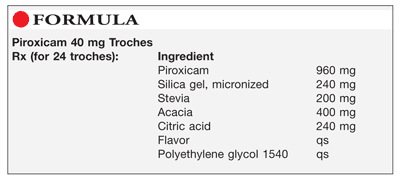US Pharm. 2014;39(1):62-63.

Method of Preparation: Note—It is necessary to calibrate the mold being used to calculate the quantity of polyethylene glycol 1540 required for this formula.
Calculate the quantity of each ingredient for the amount to be prepared. Accurately weigh or measure each ingredient. Blend the piroxicam, silica gel, stevia, acacia, and citric acid until uniform. Heat the polyethylene glycol 1540 to about 50°C. Incorporate the blended powders and cool a few degrees while stirring. Add the flavor and continue mixing. Pour the mixture into the molds, and allow it to cool and solidify. Package and label.
Use: Piroxicam troches have been used in the treatment of migraine headaches.
Packaging: Package in well-closed or tight containers.
Labeling: Keep out of reach of children. Discard after ____ [time period].
Stability: A beyond-use date of up to 6 months may be used for this preparation.1
Quality Control: Quality-control assessment can include weight, specific gravity, active drug assay, color, texture of surface, appearance, feel, melting test, dissolution test, physical observation, and physical stability.2
Discussion: Piroxicam contained in a fast-dissolving oral formulation administered sublingually has been found to be effective in the symptomatic treatment of migraine without aura.3 This study utilized piroxicam administered as a single sublingual dose within 2 hours of onset of a migraine attack. A significant reduction in pain intensity was observed in patients after only 15 minutes, and in 15 of 20 patients, the headache disappeared in 1 hour.3
Piroxicam (Feldene, C15H13N3O4S, MW 331.35) occurs as an off-white to light tan or light yellow, odorless powder. It forms a monohydrate that is yellow. Piroxicam is very slightly soluble in water, in dilute acids, and in most organic solvents. It is slightly soluble in alcohol and in aqueous alkaline solutions.1
Silica gel, a form of silicon dioxide, occurs as a fine, white, hygroscopic, odorless, amorphous powder with a usual particle size ranging from 2 µm to 10 µm. It is insoluble in water and in alcohol and other organic solvents, but is soluble in hot solutions of alkali hydroxides. Silica gel is used as a suspending agent and viscosity-increasing agent in this formula.4
Stevia (honey leaf, yerba dulce) powder is a naturally occurring sweetening agent that is extracted from the leaves of the Stevia rebaudiana Bertoni plant. Natural, nontoxic, and safe, stevia occurs as a white, crystalline, hygroscopic powder. It can be used in both hot and cold preparations.5
Acacia (gum acacia, gum arabic) is practically odorless and produces a mucilaginous sensation on the tongue. It is insoluble in alcohol. Acacia is used as a component of troches and as a binder.6
Citric acid (citric acid monohydrate, C6H8O7.H2O) occurs as colorless or translucent crystals or as a white, crystalline, efflorescent powder that is odorless and has a strong, tart, acidic taste. The hydrated form will effloresce and the anhydrous form will be hygroscopic, depending upon the humidity in the air. When stored in air that is too dry, citric acid may lose its water if the temperature reaches about 40°C. Its melting point is about 100°C, but it softens at about 75°C. One gram of citric acid is soluble in less than 1 mL of water and 1.5 mL of ethanol.7
Polyethylene glycol 1540 (Carbowax, PEG, polyoxyethylene glycol) is an addition polymer of ethylene oxide and water. At room temperature, it is a solid. Polyethylene glycol 1540 occurs as a white or off-white paste or waxy flakes, with a melting range of 40°C to 48°C. It is soluble in water and miscible in all ratios with other polyethylene glycols. It is chemically stable, does not support microbial growth, and does not become rancid.8
REFERENCES
1. U.S. Pharmacopeia 36/National Formulary 31. Rockville, MD: U.S. Pharmacopeial Convention, Inc; 2013:55-398,1279,4818-4820.
2. Allen LV Jr. Standard operating procedure for performing physical
quality assessment of suppositories, troches, lollipops and sticks. IJPC. 1999;3:56-57.
3. Nappi G, Micieli G, Tassorelli C, et al. Effectiveness of a
piroxicam fast dissolving formulation sublingually administered in the
symptomatic treatment of migraine without aura. Headache. 1993; 33:296-300.
4. Hapgood KP. Colloidal silicon dioxide. In: Rowe RC, Sheskey PJ, Quinn ME, eds. Handbook of Pharmaceutical Excipients. 6th ed. Washington, DC: American Pharmaceutical Association; 2009:185-188.
5. Reynolds JE, ed. Martindale: The Extra Pharmacopoeia. 30th ed. London, England: Pharmaceutical Press; 1993:1049.
6. Kibbe AH. Acacia. In: Rowe RC, Sheskey PJ, Quinn ME, eds. Handbook of Pharmaceutical Excipients. 6th ed. Washington, DC: American Pharmaceutical Association; 2009:1-3.
7. Amidon GE. Citric acid monohydrate. In: Rowe RC, Sheskey PJ, Cook WG, Fenton ME, eds. Handbook of Pharmaceutical Excipients. 7th ed. Washington, DC: American Pharmaceutical Association; 2012:193-196.
8. Wallick D. Polyethylene glycol. In: Rowe RC, Sheskey PJ, Quinn ME, eds. Handbook of Pharmaceutical Excipients. 6th ed. Washington, DC: American Pharmaceutical Association; 2009:517-522.
To comment on this article, contact rdavidson@uspharmacist.com.





